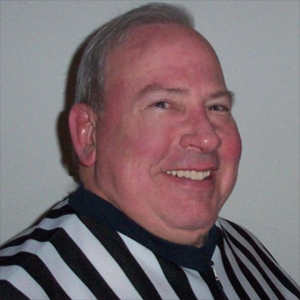
Rndballref
20 Years Experience
Chicago, IL
Male, 60
For twenty years I officiated high school, AAU and park district basketball games, retiring recently. For a few officiating is the focus of their occupation, while for most working as an umpire or basketball referee is an avocation. I started ref'ing to earn beer money during college, but it became a great way to stay connected to the best sports game in the universe. As a spinoff, I wrote a sports-thriller novel loosely based on my referee experiences titled, Advantage Disadvantage
In NFHS rules, the game is officially over when the referees leave the confines of the court so the first thing is for the referees to agree there are no game ending issues and if so quickly make your way to the lockerroom. I can't speak for everyone, but usually after the games I worked we would have a short post game wrap up in the lockerroom, maybe 10 - 15 minutes to discuss any issues or constructive criticism of each other. Depending on who were my partners we might stop for a beer on the way home as well. It used to be that in Illinois certified referees could rate other officials so I would get online and rate my partners for that game. Also, if there were any reports to the state office due (required if any player or coach was disqualified by technical fouls) I would go online and fill those out, If I had to fill out any reports to the state I would also send a copy to the assignment chairman who put me on that game.
The clock should be started when the ball is touched by an in-bounds player. If the ball is thrown out of bounds without being touched, the clock should not have been started. In your scenario, the clock should be reset to the exact time before the throw-in and the ball should be awarded to the other team for a new throw-in.
In Illinois, in each championship weekend (2 for boys & 2 for girls) there are 6 officials. Each official works 2 games, but if one were injured they could press one from the other crew into action. In addition, the tournament usually attracts several high level officials as spectators so there are plenty in reserve. Every state does this differently.
A throw-in begins when the ball is placed at the disposal of the player who will throw it in. As you describe the play, the offensive player does not have control of the ball until after fumbling it. The ref should either ignore the fumble or whistle the play dead right away and bounce the ball to the in bounder properly. Violation = bad call.
Starbucks Barista
 What's the craziest behind-the-scenes Starbucks story you have?
What's the craziest behind-the-scenes Starbucks story you have?
Bracketologist
 Where do you think the Selection Committee needs the most improvement?
Where do you think the Selection Committee needs the most improvement?
Rap Promoter / Manager
 Do rappers ever stage beefs with each other as a PR stunt?
Do rappers ever stage beefs with each other as a PR stunt?
Placing the ball on the floor repeatedly denies the other team the opportunity to grab the ball and run. Here's how it should be handled. After the second occurence, the ref should stop the game and issue a "delay of game warning" against the team, and ask the scorer to register a warning in the book.. If they do it again, the offending player should be charged with a technical foul.
I have officiated some house leagues, summer high school leagues and travelling basketball tourneys where a shooting foul is awarded 1 point and the ball, and a common foul after 7 team fouls also gets 1 point + ball. At one point in time there was a proposal in college ball that a team would have the option of shooting free throws OR the ball. Doesn't seem like anyone talks about that anymore. I think the pros like close games and slowing the game down with fouls compresses the score, but those last 2 minutes sometimes takes 20 minutes.
Simple answer: no. So again (Advantage Disadvantage), if the post player is setting up down low and swatting the defender's hands and they are in a minor way pushing or leaning on each other, then I am ignoring it or telling them hands off. But as soon as the ball is delivered to the post, and he received it because he swatted the defender's hands away from a legal guarding position, then I am calling an offensive foul.
-OR-
 Login with Facebook
Login with Facebook (max 20 characters - letters, numbers, and underscores only. Note that your username is private, and you have the option to choose an alias when asking questions or hosting a Q&A.)
(A valid e-mail address is required. Your e-mail will not be shared with anyone.)
(min 5 characters)
By checking this box, you acknowledge that you have read and agree to Jobstr.com’s Terms and Privacy Policy.
-OR-
 Register with Facebook
Register with Facebook(Don't worry: you'll be able to choose an alias when asking questions or hosting a Q&A.)